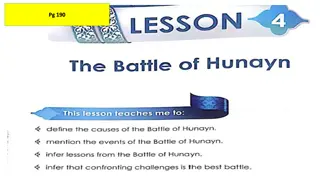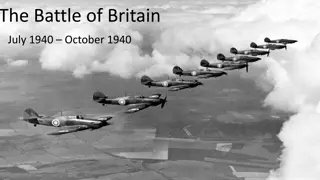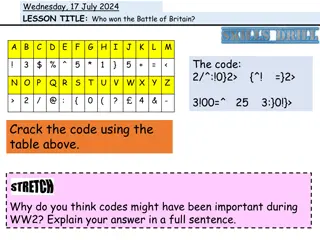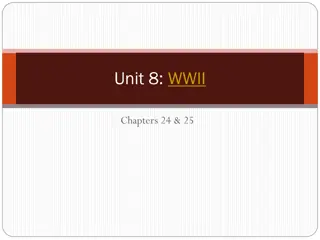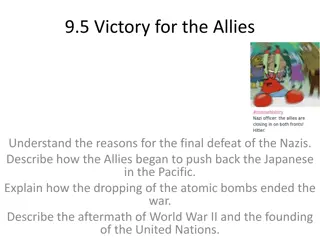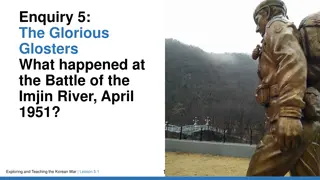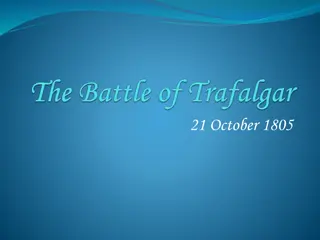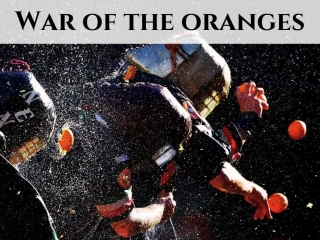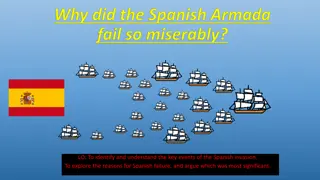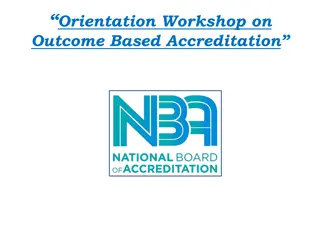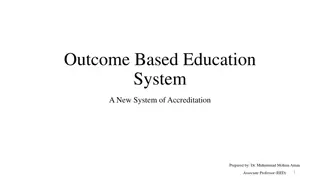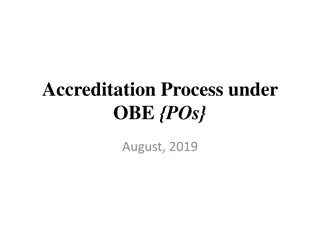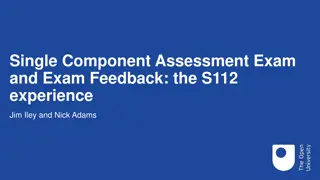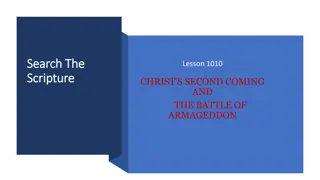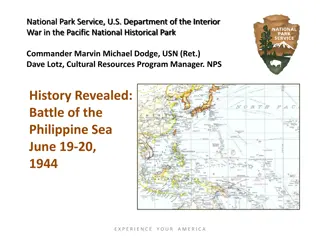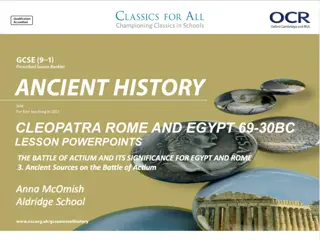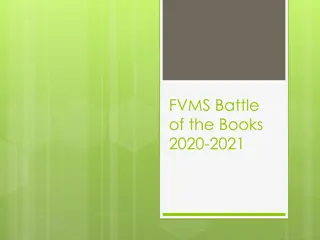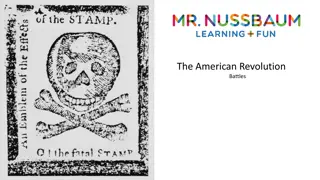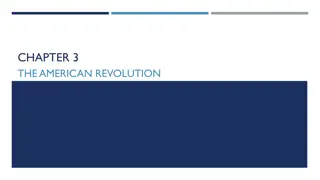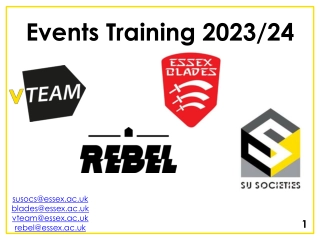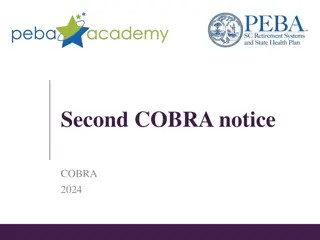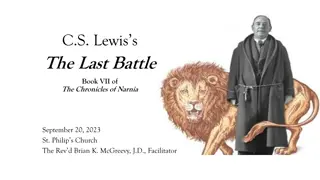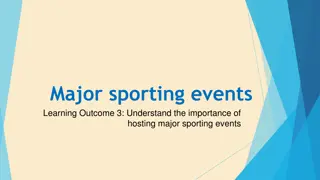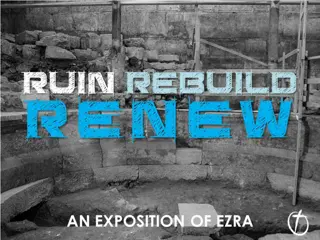The Battle of Culloden: Events, Defeat Reasons, and Outcome
The Battle of Culloden, fought in 1746, marked a significant event on British soil, involving both Scottish and English forces. The Jacobites faced defeat due to various factors, including disadvantages against the Redcoats. Despite initial strategies to surprise the Government troops, the Jacobites were met with challenges such as exhaustion and lack of supplies. Learn about the key events and reasons behind the Jacobites' loss at Culloden.
Download Presentation

Please find below an Image/Link to download the presentation.
The content on the website is provided AS IS for your information and personal use only. It may not be sold, licensed, or shared on other websites without obtaining consent from the author. Download presentation by click this link. If you encounter any issues during the download, it is possible that the publisher has removed the file from their server.
E N D
Presentation Transcript
The Battle of Culloden Pre-Clearances
The Battle of Culloden We are learning to: Describe the main events of the 1746 Battle of Culloden and the reasons for the Jacobites defeat. Success Criteria I can identify the date of the Battle of Culloden. I can list the advantages and disadvantages the Jacobites and the Redcoats had in the 1746 battle. I can explain two reasons the Jacobites lost the battle of Culloden. I can label the weapons used by a Jacobite soldier and a Redcoat soldier.
The Battle of Culloden The battle at Culloden was fought on the 16th April 1746. It was the last major battle to be fought on British soil. It is commonly believed to have been a battle between the Scottish and the English, but in reality Scottish and English fought on both sides.
The Battle of Culloden After hearing that 30,000 government troops were heading towards them, the Jacobites slowly made their way through the hills back home to the Highlands. They had barely made camp in Inverness when news arrived that Cumberland had made camp in Nairn: about 15 miles away.
Tired Exhausted, freezing, starving, out of supplies and ammunition some of his army went home to their families and some stayed.
Charles Supporters Charles thought he would take the upper hand and strike first. Just over 4,000 Jacobite supporters stood in the snow driven moors in mid morning, some had been up all night after their night march, all were starving, tired and worse for wear.. A mixture of Clans, Irish and men from the ages of 51 years to as young as 13 stood in front of a veteran force of over 9,000 well supplied infantry and cavalry.
The Night Before The Duke of Cumberland commanded the Government troops. They arrived in Nairn on April 15th, the Dukes 25th Birthday, and to celebrate the men were all given brandy. The Jacobites decided to use an old trick and sneak up on the Government forces at night and attack. They would have a huge advantage over the sleepy, hung-over and very surprised Government men.
The Night Before This should have proved to be a winning move, but moving large amounts of men across dark, marshy moorland proved problematic. Dawn was rising before the Jacobites had reached their enemies and as the element of surprise would be lost in daylight, they turned back. On arrival back at Culloden the men were exhausted and hungry, but rest was not an option as enemy forces were already approaching.
The Battle The Jacobite army, led by Bonnie Prince Charlie was around 7000 strong. The Government troops numbers were around 8000. The Jacobite army were outnumbered.
Jacobite disadvantages They were exhausted and hungry. They lacked training Their weapons were surpassed by the Governments artillery. The battleground itself was also disadvantageous, the ground being marshy and uneven with thick grasses growing underfoot.
The Battle of Culloden An 18th century hand-coloured engraving portraying the Battle of Culloden in Inverness-shire. http://www.jacobites.org.uk/iwb/culloden.html
The Battle The armies faced each other and the Jacobites slowly advanced, waiting to be given the order to break into the infamous "Highland Charge".
The Battle Some of the Government troops separated and headed for the Jacobites' right flank. While a small part of the Jacobite army broke off to protect its right flank the rest continued their advance towards the enemy.
The Battle This strategy relied on the Jacobites advancing in line formation but the uneven ground meant the flanks to the far right moved faster than the rest and lines were broken up.
Too late! The order for the Highland Charge to begin was given far too late, the right flankers being almost on top of the government when the order was given. The Jacobites didn't stand a chance. Government troops simply fired into the Jacobites, many were dead before they charged.
The Aftermath Many Jacobites fled the battlefield and those who stayed to fight were easily killed. Around 1500 Jacobites were killed that day. The Jacobites themselves only killed 50 of the Government's men. The entire battle lasted less than an hour.
Defeated Bonnie Prince Charlie felt thoroughly defeated after Culloden. His supporters were willing to fight for him again and gathered to plan their next move but the Prince ordered them to disperse. He went into hiding and fled for France.
A change to Highland life The Government wanted to punish anyone who had supported the Stuart claim to the throne. As so many of the Jacobites were made up of the Highland Clans they destroyed many of the Highlander ways of life. Clan chiefs were stripped of their power. Weapons were taken from their owners. The kilt and tartan were banned.
The Weapons of the Jacobite and Redcoat Soldiers
A Jacobite Soldier Targe A Jacobite shield is known as a targe. It is made from a circular piece of wood about 48cm in diameter, covered in leather (cowhide) on the front. The back is covered in deerskin, or cowhide (hair on), with handle and armstrap, and a leather "keeper" for the spike (if it has one). The front is hand dyed, patterned and nailed up with brass studs (sometimes up to 900 per targe).
A Jacobite Soldier Sword A Jacobite soldier would be armed with a basket-hilted broadsword. The basket protected their hand and could also trap an opponent's blade. Some Jacobite swords had slogans inscribed upon them, for example, 'God Save King James VIII' and 'Prosperity to Scotland and No Union'. The blades most sought after by the Highlanders were those bearing the "magic" name, Andrea Ferara. Ferara Highland blades are usually remarkable for their great breadth, their suppleness and fine temper. The Highland broadsword was used entirely for cutting, the point being rarely if ever used in battle.
A Jacobite Soldier Dirk All Jacobites carried their own dirk, a type of long dagger. The dirk was used for lots of different things such as eating, as well as being used for hand to hand fighting. The blade of the dirk was usually about 50cm long. In battle the Highlander would have his targe on his left arm with his dirk in his left hand with the tip of the blade sticking out the bottom of the targe. Many of the dirk blades of the 1745 period were made from the broken blades of swords shortened and fitted to dirk handles.
A Jacobite Soldier Firelock Musket Just over half of the Jacobite army had muskets. The muskets were either captured British 'Brown Bess' muskets or muskets imported from Spain or France. The Jacobites would run towards the opposing force and stop once in musket range (about 60 yards/55 metres) fire a volley and then charge forward, not bothering to reload.
A Jacobite Soldier Powder Horn Before preparing the charge for a pistol or rifle, powder was stored in a small watertight container, or horn. The term comes from the use of animal horn to form the vessel. The shape was convenient for carrying and the pointed tip could be adapted to form a spout for pouring the gunpowder into the paper charge. The vessel is prepared from a single horn from a cow. The hard shell is softened with water and then beaten and pressed to form a flat sided vessel. The wide end is sealed with a shaped wooden plug and a pouring spout of brass with a wooden plug is fitted to the cut horn tip.
A Jacobite Soldier Sporran A sporran, Gaelic for 'purse', is a pouch, often made of leather, fur and ornate metals, which is worn around the waist and commonly accompanies traditional tartan attire, such as the kilt. Today it is worn as a decorative item, but traditionally its use was more practical, serving as a container for personal items, which could not be kept in the wearer's pocket-less kilt.
A Jacobite Soldier The Jacobites had no formal uniform but they all wore a blue bonnet and a white cockade. Cockade A cockade is a length of ribbon folded into the shape of a cross which was sewn onto the left hand side of a bonnet. Local tradition says that when Bonnie Prince Charlie's army rested at Fassfern on Locheilside after raising the standard, Charlie picked a flower from the small white rose there and put it in his bonnet. During the Jacobite rising of 1745 the White Cockade was worn by the Jacobite army, a symbol of the House of Stuart. The Hanoverians wore a black cockade to show their allegiance to King George
A Redcoat Soldier Mitre The tall hat shown in the picture was called a Mitre and was designed to make the wearer look taller. Worn by Grenadiers, the cap's front had a shaped panel of material that was like the boards of a book. This was covered with a heavily embroidered piece of wool in the colour of their regiment. In 1743 it was ordered that King George II's royal cypher of a G.R. with a crown be embroidered on the front. A small red flap, with "NEC ASPERA TERRENT" (difficulties daunt us not) and the running horse of Hanover, was attached to the front. The rear of the cap had a piece of red wool stitched to the edge of the stiffened front and was kept smooth and round with two pieces of cane sewn on the inside. The rear bottom band was made of wool of the regiment's colour and had embroidered on it, along with other ornamentation, the numbers of the regiment and a grenade. Completing the cap was a woollen tuft at the top.
A Redcoat Soldier Musket From the 1730s the Redcoats used the Brown Bess musket. A well trained soldier could fire up to four rounds per minute, and by standing in three lines meant that a constant volley of fire could be employed. Lots could go wrong with the musket - from misfires in wet weather, to the gun firing at random due to sparks which set the powder off. In the heat of war a soldier may forget to remove the ramrod from the barrel before firing, and the inaccuracy of the flintlock (even though it was more reliable than the matchlock) meant that the enemy had to be within at least 30 paces for an accurate shot to be fired.
A Redcoat Soldier Bayonet A sword-like stabbing blade which was fixed to the muzzle of a gun for use in hand to hand fighting. The Battle of Culloden was the first time that a new bayonet drill was adopted by the Royalist forces. The technique involved directing thrusts at the Highlander to their right, rather than at the one directly in front of them.
A Redcoat Soldier British Infantry Sword The Redcoats used a standard infantry pattern sword that they had to pay for themselves. This was the main sidearm of the British Army in the Mid 18th Century. A sword of the 'Hanger' type, the short 25 blade is slightly curved, single-edged blade. The heart shaped hilt is entirely cast in brass with the grip cast in a spiral pattern. This type of weapon was used extensively by private soldiers and sergeants during the wars with France in the early 18th century and during the 1745 Jacobite Rebellion including the battle of Culloden.
A Redcoat Soldier Can you identify the weapons of the Redcoat soldier?
A Jacobite Soldier Can you identify the weapons of the Jacobite soldier?


